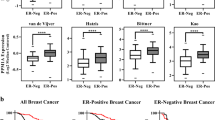Abstract
The major goal of this work was to study the intracellular signaling pathways responsible for the development of hormone resistance and maintenance of the autonomous growth of breast cancer cells. Particularly, the role of PAK1 (p21-activated kinase 1), the key mitogenic signaling protein has been analyzed in the context of the development of cell resistance to estrogens. In vitro studies were performed on cultured breast cancer cell lines: estrogen-dependent estrogen receptor (ER)-positive MCF-7 cells and estrogen-resistant ER-negative HBL-100 cells. We found that the resistant HBL-100 cells were characterized by a higher level of PAK1 and demonstrated PAK1 involvement in the maintenance of estrogen-independent cell growth. Studying downstream signaling pathways activated by PAK1, we have found Snail1, an epithelial-mesenchymal transition protein, as one of PAK1 effectors and obtained experimental evidence for importance of Snail1 in the regulation of cell proliferation. In general, the results obtained in this study demonstrate involvement of PAK1 and Snail1 in the formation of estrogen-independent phenotype of breast cancer cells thus showing the potential role of both proteins as markers of hormone resistance of breast tumors.
Similar content being viewed by others
References
Krasil’nikov, M.A., Vopr. onkol., 2004, vol. 50, pp. 399–405.
Normanno, N., Di Maio, M., De Maio, E., De Luca, A., de Matteis, A., et al., Endocr. Relat. Cancer, 2005, vol. 12, pp. 721–747.
Clarke, R., Liu, M.C., Bouker, K.B., Gu, Z., Lee, R.Y., et al., Oncogene, 2003, vol. 22, pp. 7316–7339.
Jordan, V.C., Ann. Oncol., 2003, vol. 14, pp. 969–970.
Jalava, P., Kuopio, T., Huovinen, R., Laine, J., and Collan, Y., Anticancer Res., 2005, vol. 25, pp. 2535–2542.
Henderson, B.E., Ponder, B.A.J., and Ross, R.K., Hormones, Genes and Cancer New York: Oxford University Press, p. 120–139.
Kichina, J.V., Goc, A., Al-Husein, B., Somanath, P.R., and Kandel, E.S., Expert Opin. Ther. Targets, 2010, vol. 14, pp. 703–725.
Molli, P.R., Li, D.Q., Murray B.W., Rayala, S.K., and Kumar, R., Oncogene, 2009, vol. 28, pp. 2545–2555.
Ghosh, A., Awasthi, S., Peterson, J.R., and Hamburger, A.W., Br. J. Cancer, 2013, vol. 108, pp. 557–563.
Kok, M., Zwart, W., Holm, C., Fles, R., Hauptmann, M., et al., Breast Cancer Research and Treatment, 2011, vol. 125, pp. 1–12.
Bostner, J., Skoog, L., Fornander, T., Nordenskjold, B., and Stal, O., Clinical Cancer Research, 2010, vol. 16, pp. 1624–1633.
Arias-Romero, L.E. and Chernoff, J., Small GTPases, 2010, vol. 1, pp. 124–128.
Yang, Y., Du, J., Hu, Z., Liu, J., Tian, Y., et al., J. Biomed. Res., 2011, vol. 25, pp. 237–245.
Krasil’nikov, M.A., Shatskaya, V.A., Stavrovskaya, A.A., Erohina, M., Gershtein, E.S., et al. Biochim. Biophys. Acta, 1999, vol. 1450, pp. 434–443.
Reid, G., Hubner, M.R., Metivier, R., Brand, H., Denger, S., et al., Mol. Cell, 2003, vol. 11, pp. 695–707.
Vincent, T., Neve, E.P., Johnson, J.R., Kukalev, A., Rojo, F., et al., Nat. Cell Biol., 2009, vol. 11, pp. 943–950.
Lobanova, Y.S., Scherbakov, A.M., Shatskaya, V.A., Evteev, V.A., and Krasil’nikov, M.A., Mol. Cell Biochem., 2009, vol. 324, pp. 65–71.
Scherbakov, A.M., Andreeva, O.E., Shatskaya, V.A., and Krasil’nikov, M.A., J. Cell. Biochem., 2012, vol. 113, pp. 2147–2155.
Dhasarathy, A., Kajita, M., and Wade, P.A., Mol. Endocrinol., 2007, vol. 21, pp. 2907–2918.
Fujita, N., Jaye, D.L., Kajita, M., Geigerman, C., Moreno, C.S., et al., Cell, 2003, vol. 113, pp. 207–219.
Sells, M.A., Knaus, U.G., Bagrodia, S., Ambrose, D.M., Bokoch, G.M., and Chernoff, J., Curr. Biol., 1997, vol. 7, pp. 202–210.
Author information
Authors and Affiliations
Corresponding author
Additional information
Original Russian Text © E.A. Avilova, O.E. Andreeva, V.A. Shatskaya, M.A. Krasil’nikov, 2015, published in Biomeditsinskaya Khimiya.
Rights and permissions
About this article
Cite this article
Avilova, E.A., Andreeva, O.E., Shatskaya, V.A. et al. The role of protein kinase PAK1 in the regulation of estrogen-independent growth of breast cancer. Biochem. Moscow Suppl. Ser. B 9, 58–62 (2015). https://doi.org/10.1134/S1990750815010023
Received:
Published:
Issue Date:
DOI: https://doi.org/10.1134/S1990750815010023




